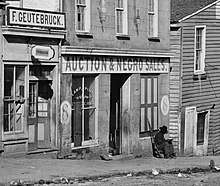History of slavery in Georgia (U.S. state)
Slavery in Georgia is known to have been practiced by the original or earliest-known inhabitants of the future colony and state of Georgia, for centuries prior to European colonization. During the colonial era, the practice of Indian slavery in Georgia soon became surpassed by industrial-scale plantation slavery.
The penal colony of the Province of Georgia under James Oglethorpe banned slavery in 1735, the only one of the thirteen colonies to have done so. However, it was legalized by royal decree in 1751,[1] in part due to George Whitefield's support for the institution of slavery.
Early slavery
Native Americans enslaved members of their own and other tribes before Europeans arrived (and afterwards, continuing into the 1800s); slaves might or might not be adopted eventually, especially if enslaved as children; and the enslavement might or might not be hereditary.[2] [3] Slaves included captives from wars and slave raids; captives bartered from other tribes, sometimes at great distances; children sold by their parents during famines; and men and women who staked themselves in gambling when they had nothing else, which put them into servitude in some cases for life.[2]
The first enslaved Africans in what would become the present day United States of America arrived in 1526 with Lucas Vázquez de Ayllón's establishment of San Miguel de Gualdape on the current Georgia or Carolina coast.[4] [5] [6] They rebelled and lived with indigenous people, destroying the colony in less than 2 months.[4][7]
Birthplace of the cotton gin
Georgia figures significantly in the history of American slavery because of Eli Whitney's invention of the cotton gin in 1793. The gin was first demonstrated to an audience on Revolutionary War hero General Nathanael Greene's plantation, near Savannah.
The cotton gin's invention led to both the burgeoning of cotton as a cash crop and to the revitalization of the agricultural slave labor system in the southern states. The Southern economy soon became dependent upon cotton production and the sale of cotton to northern and English textile manufacturers.
Georgia slavery during the Civil War

Georgia voted to secede from the Union and join the Confederate States of America on January 19, 1861. Years later, in 1865, during his March to the Sea, Gen. William Tecumseh Sherman signed his Special Field Orders, No. 15, distributing some 400,000 acres (1,600 km²) of confiscated land along the Atlantic coast from Charleston, South Carolina, to the St. Johns River in Florida to the slaves freed by the Union Army. Most of the settlers and their descendants are today known as the Gullah.
Slavery was officially abolished by the Thirteenth Amendment, which took effect on December 18, 1865. Slavery had been theoretically abolished by President Abraham Lincoln's Emancipation Proclamation in 1863, which proclaimed that only slaves located in territories that were in rebellion from the United States were free. Since the U.S. government was not in effective control of many of these territories until later in the war, many of these slaves proclaimed to be free by the Emancipation Proclamation were still held in servitude until those areas came back under Union control.
Commemoration
In 2002, the City of Savannah unveiled a bronze statue on River Street in commemoration of the Africans who were brought to this country as slaves through the city's port.
In 2005, Wachovia Bank apologized to Georgia's African-American community for its predecessor (Georgia Railroad and Banking Company of Augusta)'s role in the use of at least 182 slaves in the construction of the Georgia Railroad.[8]
See also
References
- Marsh, Ben (2007). "Planting families: Intent and outcome in the development of colonial Georgia". History of the Family. 12 (104–115): 104–115. doi:10.1016/j.hisfam.2007.08.003.
- Lauber, Almon Wheeler (1913). "Enslavement by the Indians Themselves, Chapter 1 in Indian Slavery in Colonial Times Within the Present Limits of the United States". 53 (3). Columbia University: 25–48. Cite journal requires
|journal=(help) - Gallay, Alan (2009). "Introduction: Indian Slavery in Historical Context". In Gallay, Alan (ed.). Indian Slavery in Colonial America. Lincoln, NE: University of Nebraska Press. pp. 1–32. Retrieved March 8, 2017.
- Cameron, Guy, and Stephen Vermette; Vermette, Stephen (2012). "The Role of Extreme Cold in the Failure of the San Miguel de Gualdape Colony". The Georgia Historical Quarterly. 96 (3): 291–307. ISSN 0016-8297. JSTOR 23622193.
- Parker, Susan (2019-08-24). "'1619 Project' ignores fact that slaves were present in Florida decades before". St. Augustine Record. Retrieved 2019-12-06.
- Francis, J. Michael, Gary Mormino and Rachel Sanderson (2019-08-29). "Slavery took hold in Florida under the Spanish in the 'forgotten century' of 1492-1619". Tampa Bay Times. Retrieved 2019-12-06.
- Torres-Spelliscy, Ciara; Law, a fellow at the Brennan Center for Justice at NYU School of; Br, the author of "Political; s." (2019-08-23). "Perspective - Everyone is talking about 1619. But that's not actually when slavery in America started". Washington Post. Retrieved 2019-12-06.
- Fears, Darryl (2005-06-20). "Seeking More Than Apologies for Slavery". The Washington Post. Retrieved 2019-02-24.
Further reading
- Jennison, Watson. Cultivating Race: The Expansion of Slavery in Georgia, 1750-1860. Lexington, KY: University Press of Kentucky, 2012.
- Wilson, Charles Hooper (2011). "Slave Ownership in Early Georgia: What Eighteenth-Century Wills Reveal". Historical Methods. 44 (3): 115–126. doi:10.1080/01615440.2010.506423.
- Wood, Betty. Slavery In Colonial Georgia, 1730-1775 (2007).
External links
- "Slavery in Antebellum Georgia" from the New Georgia Encyclopedia
- Georgia's Slave Population in Legal Records, by David E. Paterson
- 1861 Georgia slave map from Harper's Weekly; accessed on 1 April 2015.
- Sherman's Special Field Orders, No. 15, January 1865 Accessed on 1 April 2015.
